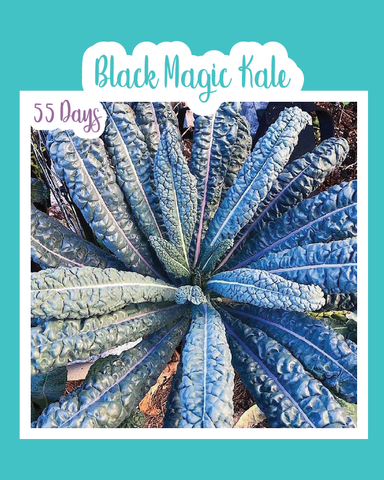
White Russian Kale
Seed Count: Approx. 200 seeds
Days to Maturity: 50 Days
Description: The White Russian kale has the same classic Red Russian kale toothed leaf shape, except it boasts dainty white veins. Its deep blue-green, 24 inch leaves are broad and serrated at the edges. It grows in a vigorous upright habit, offering you multiple harvests from one plant. Eat this delicious, sweet kale raw in salads, made into side dishes, or added into casseroles, soups, and stews. It can be harvested as sweet tender baby greens, or you can wait until your leaves are fully mature to harvest in bunches. It's pretty heat tolerant, but the leaves sweeten even more after a frost, and is one of the most cold hardiest, wet soil tolerant kales around. Pair this tasty green with Red Russian Kale for a beautiful contrast.
How To Grow
Sowing: Since kale thrives in cool weather and sweetens with frost, it grows best as a fall crop. Plant 3 seeds in a cluster, 1/2" deep and 16-18" apart in rows 2-3' apart about 3 months before first expected frost. Thin to the strongest plant when the seedlings emerge. Kale appreciates very rich, moist soil that drains well, since they taste best when allowed to grow quickly.
Growing: Keep weeds controlled and conserve moisture by applying mulch. Keep the soil evenly moist, but stop watering after the first frost. Kale is very easy to grow, but can be bothered by cabbage aphids.
Harvesting: Harvest baby leaves as soon as they grow big enough for salad; harvest bigger leaves as needed. Use a scissors or a knife to cut the leaves, to avoid tearing the stems. To harvest the entire plant, cut it off an inch above ground level. To make the fresh leaves last longer in the fridge, dip the stems in water after cutting them; they should stay fresh for up to a month. Kale also freezes well. Expect to harvest well after frost, since most varieties of kale can survive freezing temperatures. Kale must overwinter before producing seeds; since it survives cold well, a thick layer of mulch should protect it sufficiently, even in colder climates. In the spring, allow it to flower and go to seed. Some of the leaves can still be harvested for eating without damaging the seed development. The tall stalk will develop pods that ripen from the bottom up; wait until the pods turn light brown before harvesting them.




